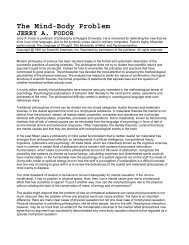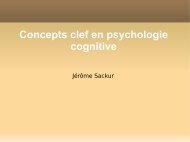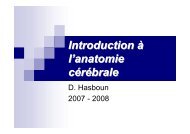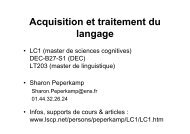From single to multiple deficit models of developmental disorders
From single to multiple deficit models of developmental disorders
From single to multiple deficit models of developmental disorders
You also want an ePaper? Increase the reach of your titles
YUMPU automatically turns print PDFs into web optimized ePapers that Google loves.
410 B.F. Penning<strong>to</strong>n / Cognition 101 (2006) 385–413<br />
Harm, M. W., & Seidenberg, M. S. (1999). Phonology, reading acquisition, and dyslexia: insights from connectionist<br />
<strong>models</strong>. Psychological Review, 10(3), 491–528.<br />
Hin<strong>to</strong>n, G. E., & Shallice, T. (1991). Lesioning an attrac<strong>to</strong>r network: investigations <strong>of</strong> acquired dyslexia.<br />
Psychological Review, 98, 96–121.<br />
Ho, C. S., Chan, D. W., Tsang, S. M., & Lee, S. H. (2002). The cognitive proWle and <strong>multiple</strong>-deWcit hypothesis<br />
in Chinese <strong>developmental</strong> dyslexia. Developmental Psychology, 3(4), 543–553.<br />
Kamhi, A. G., Catts, H. W., Mauer, D., Apel, K., & Gentry, B. F. (1988). Phonological and spatial processing<br />
abilities in language- and reading-impaired children. Journal <strong>of</strong> Speech and Hearing Disorders, 5(3),<br />
316–327.<br />
KarmiloV-Smith, A., Brown, J. H., Grice, S., & Patterson, S. (2003). Detthroning the myth: cognitive<br />
dissociations and innate modularity in Williams syndrome. Developmental Neuropsychology, 2(1–2),<br />
227–242.<br />
Klein, D. N., & Riso, L. P. (1993). Psychiatric <strong>disorders</strong>: problems <strong>of</strong> boundaries and comorbidity. In C. G.<br />
Costello (Ed.), Basic issues in psychopathology (pp. 19–66). New York: Guilford Press.<br />
Leonard, L. B. (1982). Phonological deWcits in children with <strong>developmental</strong> language impairment. Brain<br />
and Language, 1(1), 73–86.<br />
Lewis, B. A. (1990). Familial phonological <strong>disorders</strong>: fur pedigrees. Journal <strong>of</strong> Speech and Hearing Disorders,<br />
5(1), 160–170.<br />
Lewis, B. A. (1992). Genetics in speech <strong>disorders</strong>. Clinical Communication Disorders, 2(4), 48–58.<br />
Lewis, B. A., Ekelman, B. L., & Aram, D. M. (1989). A familial study <strong>of</strong> severe phonological <strong>disorders</strong>.<br />
Journal <strong>of</strong> Speech and Hearing Research, 3(4), 713–724.<br />
Lewis, B. A., & Freebairn, L. (1992). Residual eVects <strong>of</strong> preschool phonology <strong>disorders</strong> in grade school,<br />
adolescence, and adulthood. Journal <strong>of</strong> Speech and Hearing Research, 35(4), 819–831.<br />
Light, J. G., Penning<strong>to</strong>n, B. F., Gilger, J. W., & DeFries, J. C. (1995). Reading disability and hyperactivity<br />
disorder: eidence for a common genetic etiology. Developmental Neuropsychology, 11, 323–335.<br />
Loo, S. K., Fisher, S. E., Francks, C., Ogdie, M. N., MacPhie, I. L., Yang, M., et al. (2004). Genome-wide<br />
scan <strong>of</strong> reading ability in aVected sibling pairs with attention-deWcit/hyperactivity disorder: unique and<br />
shared genetic eVects. Molecular Psychiatry, 9(5), 485–493.<br />
Lyytinen, H., Ahonen, T., Eklund, K., Gut<strong>to</strong>rm, T. K., Laakso, M. L., Leinone, S., et al. (2002). Developmental<br />
pathways <strong>of</strong> children with and without familial risk for dyslexia during the Wrst years <strong>of</strong> life.<br />
Developmental Neuropsychology, 20(2), 535–554.<br />
Magnusson, E., & Naucler, K. (1990). Reading and spelling in language disordered children-linguistic<br />
and metalinguistic pre-requisites: areport on a longitudinal study. Clinical Linguistics and Phonetics, 4,<br />
49–61.<br />
Manis, F. R., Seidenberg, M. S., Doi, L. M., McBride-Chang, C., & Petersen, A. (1996). On the bases <strong>of</strong> two<br />
subtypes <strong>of</strong> <strong>developmental</strong> dyslexia. Cognition, 58(2), 157–195.<br />
Marlow, A. J., Fisher, S. E., Francks, C., MacPhie, I. L., Cherny, S. S., Richardson, A. J., et al. (2003). Use <strong>of</strong><br />
multivariate linkage analysis for dissection <strong>of</strong> a complex cognitive trait. American Journal <strong>of</strong> Human<br />
Genetics, 72(3), 561–570.<br />
Mattis, T., French, J. H., & Rapin, I. (1975). Dylexia in children and young adults: tree independent neuropsychological<br />
syndromes. Developmental and Medical Child Neurololgy, 17(2), 150–163.<br />
Montgomery, J. W. (1995). Sentence comprehension in children with speciWc language impairment: te role<br />
<strong>of</strong> phonological working memory. Journal <strong>of</strong> Speech and Hearing Research, 38(1), 187–199.<br />
Morris, R. D., Shaywitz, S. E., Shankweiler, D. P., Katz, L., Stuebing, K. K., Fletcher, J. M., et al. (1998).<br />
Subtypes <strong>of</strong> reading disability: variability around a phonological core. Journal <strong>of</strong> Educational Psychology,<br />
90, 347–373.<br />
Mor<strong>to</strong>n, J. (2004). Understanding <strong>developmental</strong> <strong>disorders</strong>. Oxford: Blackwell.<br />
Mor<strong>to</strong>n, J., & Frith, U. (1995). Causal modeling: a structural approach <strong>to</strong> <strong>developmental</strong> psychopathology.<br />
In D. Cicchetti & D. J. Cohen (Eds.), Developmental psychopathology (Vol. 1, pp. 357–390). New<br />
York: John Wiley & Sons.<br />
Nation, K., & Snowling, M. (1997). Assessing reading diYculties: the validity and utility <strong>of</strong> current measures<br />
<strong>of</strong> reading skill. British Journal <strong>of</strong> Educational Psychology, 67(Pt. 3), 359–370.<br />
Neale, M., & Cardon, L. (1992). Methodology for genetic studies <strong>of</strong> twins and families. Dordrecht: Kluwer.







